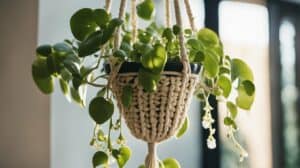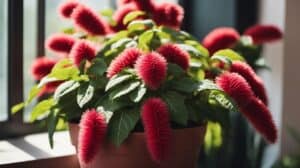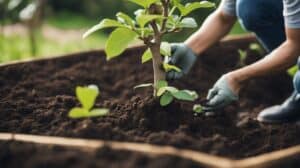Button ferns, also known as Pellaea rotundifolia, are a popular choice for indoor gardening due to their small size and unique appearance.
These ferns are native to New Zealand and are often grown for their round, button-like leaflets that grow in a circular pattern.
Button ferns are relatively easy to care for, making them an excellent choice for beginners who are looking to expand their plant collection.

One of the key factors in cultivating healthy button ferns is providing them with the right growing conditions.
These ferns prefer bright, indirect light and well-draining soil that is kept consistently moist.
They also thrive in humid environments, so it’s important to mist their leaves regularly or place them near a humidifier.
With the proper care, button ferns can grow up to 12 inches tall and 18 inches wide, making them a great addition to any indoor garden.
Understanding Pellaea Rotundifolia

Defining Button Fern
Button fern, also known as Pellaea rotundifolia, is a small fern species that is easy to cultivate and often used as a houseplant.
It gets its name from the small, round leaflets that grow in a circular pattern along the stem, giving it a button-like appearance.
Species Overview
Pellaea rotundifolia is a member of the Pteridaceae family and is native to the western United States, Mexico, and South America.
It typically grows to be about 6-12 inches tall and wide, making it a great choice for small spaces.
The fronds are usually a bright green color and have a delicate, lacy appearance.
Button ferns are relatively low-maintenance plants and can thrive in a variety of conditions. They prefer bright, indirect light and well-draining soil.
They also require consistent moisture, but should not be overwatered as this can lead to root rot.
Native Habitat
In its native habitat, Pellaea rotundifolia can be found growing in rocky crevices, on cliffs, and in other areas with well-draining soil.
It is also commonly found growing on tree trunks and other surfaces as an epiphyte.
Overall, button ferns are a great choice for beginners looking to add a touch of green to their indoor space.
With the right care, they can thrive and add a unique look to any room.
Cultivation Essentials
Light Requirements
Button ferns need moderate to bright indirect light to grow well.
Direct sunlight can scorch the leaves, so it is best to place them in a spot that receives bright, filtered light.
North or east-facing windows are ideal for button ferns. If the plant is not getting enough light, the leaves may turn yellow and drop off.
Soil Composition
Button ferns prefer well-draining soil that is rich in organic matter.
A good potting mix for button ferns should contain peat moss, perlite, and vermiculite. The soil should be kept moist but not waterlogged.
Overwatering can lead to root rot and other fungal diseases.
Watering Techniques
Button ferns require consistent moisture to thrive. Water the plant when the top inch of soil feels dry to the touch.
Use room temperature water and avoid getting water on the leaves, as this can cause spotting and damage.
It is important to not let the soil dry out completely, as this can lead to stress and damage to the plant.
Temperature and Humidity
Button ferns prefer warm, humid environments. They thrive in temperatures between 60-75°F (15-24°C) and humidity levels between 50-70%.
To increase humidity, place a tray of water near the plant or use a humidifier.
Avoid placing the plant near drafts or in areas with fluctuating temperatures, as this can cause stress and damage to the plant.
Propagation and Growth

Spore Propagation
Button ferns can be propagated through spores. Spores are tiny, dust-like particles that can be found on the undersides of mature fronds.
To propagate with spores, follow these steps:
- Collect spores from mature fronds by placing a piece of paper underneath the frond and tapping it gently.
- Sprinkle the spores on top of a pot filled with a mixture of peat moss and sand.
- Cover the pot with plastic wrap to create a humid environment and place it in a warm, bright location.
- Keep the soil moist and mist the spores regularly.
- After a few weeks, small green shoots will appear. Let them grow until they are large enough to transplant into individual pots.
Division Method
Button ferns can also be propagated through division.
This method involves separating the root ball of an established plant into smaller sections and planting them individually. Here’s how to do it:
- Remove the fern from its pot and gently shake off excess soil.
- Use a sharp, clean knife to divide the root ball into smaller sections.
- Each section should have a healthy root system and several fronds.
- Plant each section in a pot filled with a mixture of peat moss and sand.
- Water the newly planted ferns and keep them in a warm, bright location.
- As the ferns grow, make sure to keep the soil moist and mist the fronds regularly.
By following these simple propagation methods, beginners can successfully grow and cultivate Button Ferns.
Common Challenges

Pest Management
Button ferns are generally hardy plants, but they can be susceptible to pests such as spider mites, mealybugs, and scale insects.
These pests can cause damage to the leaves and stems of the plant, and can even lead to the death of the fern if not properly managed.
To prevent pests from infesting your button fern, it is important to keep the plant healthy and well-maintained.
Regularly inspect the plant for signs of infestation, such as yellowing leaves, webbing, or sticky residue on the leaves.
If you do notice an infestation, there are a few steps you can take to manage the problem.
Firstly, isolate the affected plant to prevent the infestation from spreading to other plants.
Then, use an insecticidal soap or neem oil to treat the affected areas. Repeat the treatment as necessary until the infestation is under control.
Disease Prevention
Button ferns are also susceptible to fungal diseases, which can cause wilting, yellowing, and browning of the leaves.
To prevent fungal diseases from affecting your fern, it is important to avoid overwatering and to provide good air circulation around the plant.
If you do notice signs of fungal disease, such as discolored or wilting leaves, it is important to act quickly to prevent the spread of the disease.
Remove any affected leaves and treat the plant with a fungicide. Be sure to follow the instructions on the fungicide carefully to avoid damaging the plant.
Addressing Common Issues
In addition to pests and diseases, button ferns can also experience other common issues such as yellowing leaves, brown tips, and stunted growth.
These issues can be caused by a variety of factors, including overwatering, underwatering, low light, and nutrient deficiencies.
To address these issues, it is important to identify the root cause and take appropriate action.
For example, if the plant is overwatered, reduce the frequency of watering and ensure that the soil is well-draining.
If the plant is not receiving enough light, move it to a brighter location or provide additional artificial light.
By addressing these common issues and taking steps to prevent pests and diseases, you can ensure that your button fern thrives and remains a beautiful addition to your indoor garden.
Frequently Asked Questions

How do you care for a button fern indoors?
Button ferns are relatively easy to care for indoors. They thrive in bright, indirect light and prefer to be kept in a humid environment.
It’s important to keep the soil consistently moist but not waterlogged, and to avoid letting the plant dry out completely.
Button ferns also benefit from occasional misting or a pebble tray to increase humidity levels.
What are the signs of overwatering in button ferns?
Overwatering is a common problem with button ferns.
Signs of overwatering include yellowing leaves, wilting, and a mushy or rotten smell coming from the soil.
If you suspect your button fern is overwatered, allow the soil to dry out slightly before watering again, and adjust your watering schedule accordingly.
How often should button ferns be fertilized, and what type should be used?
Button ferns benefit from regular fertilization during the growing season (spring and summer).
A balanced, water-soluble fertilizer can be used every two to four weeks, following the manufacturer’s instructions.
During the dormant season (fall and winter), fertilization can be reduced or stopped altogether.
What is the ideal potting mix for growing a healthy button fern?
Button ferns prefer a well-draining potting mix that is rich in organic matter. A mix of peat moss, perlite, and vermiculite is a good choice.
It’s also important to choose a pot with drainage holes to prevent water from accumulating in the soil.
Can button ferns be propagated, and what is the best method?
Yes, button ferns can be propagated through division or spores.
Division involves separating the plant at the root ball and replanting each section in its own pot.
Spores can be collected from the underside of mature fronds and planted in a mixture of peat moss and sand.
Both methods require patience and care, but can result in healthy new plants.
Are button ferns safe for pets, or are they toxic?
Button ferns are non-toxic and safe for pets, making them a great choice for pet owners looking to add some greenery to their homes.
However, it’s always a good idea to monitor your pets around plants and seek veterinary care if you suspect they have ingested any part of the plant.














